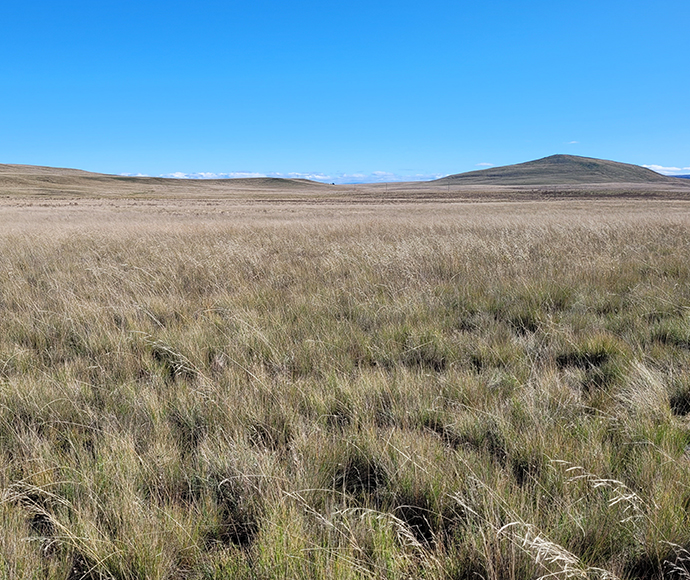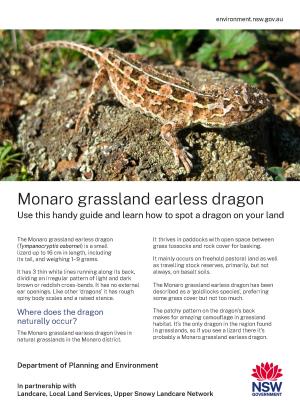The Monaro, Southern and Central tablelands are home to the natural temperate grassland. The grassland provides habitat for some strange and fascinating plants and animals.
Grassland earless dragons, golden sun moths and little whip snakes are just some of the threatened species that call the grasslands home. Natural temperate grassland is listed as a critically endangered ecological community and protecting it is key to the survival of these species.
Farmers and other land managers are continually improving their understanding of the grasslands with help from ecologists and scientists. This makes them key to this grassland protection through actions such as sustainable native grazing, weed control, ecological fire and getting involved with annual monitoring of these species.
Natural temperate grasslands

Natural temperate grasslands are made up of perennial native grass species and a diversity of other native plants. These include lilies, peas, daisies and orchids that are collectively known as forbs, along with sedges, rushes and ferns.
Many of the mammals, birds, reptiles and insects that live in natural temperate grassland are unique to this type of habitat in south-eastern NSW.
Grasslands are usually treeless and occur in areas where woody vegetation doesn’t grow, for a range of reasons.
Most of the remnant native grasslands found across valley floors and basalt plains of the Monaro and Southern tablelands and native grassland through the Central Tablelands are listed as the critically endangered ecological community, natural temperate grassland of the south eastern highlands.
Grassland earless dragons
As dragons go, they’re pretty small, but the tiny grassland earless dragon receives a huge amount of love from both the ecological and broader community. The quest is ongoing to understand the best way to monitor the species and manage their habitat.
Grassland earless dragons are tiny. They measure up to 15 cm long including their tail. They have 3 lines running down their back with a brown blotchy pattern on their skin, which provides good camouflage in their grassy habitats. They eat all sorts of bugs and insects, including ants, small spiders, grasshoppers, moths and beetles.
Grassland earless dragons use wolf spider holes and similar burrows for shelter and egg-laying. Contrary to what their name suggests, these dragon lizards aren’t earless but just lack external ear openings.
Canberra grassland earless dragon

The Canberra grassland earless dragon (Tympanocryptis lineata) is one of Australia’s most threatened reptiles.
These dragons live in a handful of known spots in and around Canberra and Queanbeyan on Ngunnawal and Ngambri land. Their numbers are in decline partly because populations are unable to mix easily and are genetically isolated due to roads and infrastructure in the region.
The populations suffered sharp declines in the millennium drought (2002–2010) and at the end of the 2018–2020 drought, with some sites starting to see declines in the years leading up to this.
In NSW, our ecologists keep a close eye on numbers every year. Similar surveys are conducted over the border in Canberra.
Monitoring is focused on checking monitoring tubes or artificial spider burrows each year. The results of our population monitoring in recent years have been concerning. For example, in:
- 2018, 58 individual dragons were found in tubes
- 2019, 34 were found
- 2020, 4 were found
- 2021, no dragons were found.
But, there was some good news in 2022 when 4 individuals were found across 3 different sites.
This recovery has continued, with 6 individuals found across 2 sites in 2023 and 16 across 3 sites in 2024. Five of these have been added to the Tidbinbilla captive breeding colony to enhance the genetic diversity of this colony in preparation for future releases back into the wild.
There is still an incredibly long way to go to improve the conservation status of this species. However, their ongoing presence, albeit at very low numbers, and the potential for captive breeding gives hope that if the grasslands can be managed effectively then the dragons will continue to survive.
Monaro grassland earless dragon

Take the highway from Canberra to Ngarigo Country around Cooma and you will find the Monaro grassland earless dragon (Tympanocryptis osbornei). Like its Canberran cousin, it is increasingly affected by the change in climate.
Our work, alongside partners, involves targeting management at sites across the Monaro to give the dragons the best chance to persist into the future.
Saving our Species ecologists describe this dragon as a true ‘goldilocks species’ because it doesn’t like too much grass cover nor too little. The ideal habitat for a dragon includes grass tussocks around 7 to 13 cm high, a range of forbs, surface rock and small patches of bare ground creating important structural diversity.
Dragons can face challenges when:
- in drought years there isn’t enough grass
- grazing pressure is too great
- a season is very wet the biomass can possibly be too high.
The impact of high grass growth in areas known to have dragons is difficult to determine due to the cryptic nature of the species and challenges in detectability with high biomass. We are looking at options for understanding the impact of high biomass, and if needed, for managing grass levels to create the right combination of bare ground and grass the dragons need for their habitat.
As with the Canberra dragons, monitoring in the Monaro is focused on checking monitoring tubes or artificial spider burrows each year. Since 2019 average occupancy across the Monaro declined from 2019 to 2022. That trajectory has since reversed, with occupancy slowly increasing in 2023 and 2024 from the 2022 low. Excitingly, dragons have been found this year in high biomass sites where they have not been seen for many years.
Bathurst grassland earless dragon
The Bathurst grassland earless dragon (Tympanocryptis mccartneyi) is restricted to naturally treeless or sparsely treed grasslands on the alluvial plains around Bathurst in Wiradjuri Country.
We know little about this dragon as it has not been encountered for over 30 years. What we do know, is based on a limited number of sightings and 3 specimens collected from Bathurst in 1966 and the early 1990s.
Locating and conserving any remaining populations will depend on the expert knowledge of local naturalists, landholder cooperation, and targeted surveys across remnant native grasslands in the Bathurst, Orange, Blaney and Oberon regions and towards Cowra.
Survey arrays have recently been installed in preparation for monitoring in the upcoming season. The recent rediscovery of the Victorian grassland earless dragon (Tympanocryptis pinguicolla) after 54 years has provided renewed hope for the rediscovery of the Bathurst grassland earless dragon.
Managing grass levels
Saving our Species ecologists and local land managers are investigating ways to reduce biomass and create a habitat mosaic across the Canberra and Monaro sites for the dragons to accommodate increased grass growth after a few wet years.






